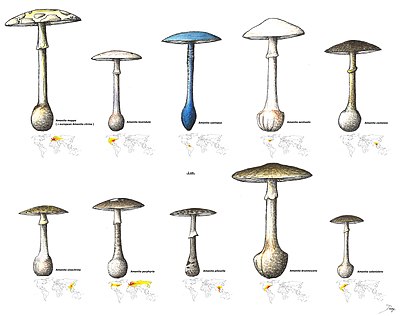Amanita citrina
| Amanita citrina | |
|---|---|

| |
| Scientific classification | |
| Kingdom: | Fungi |
| Division: | Basidiomycota |
| Class: | Agaricomycetes |
| Order: | Agaricales |
| Family: | Amanitaceae |
| Genus: | Amanita |
| Species: | A. citrina
|
| Binomial name | |
| Amanita citrina (Schaeff.) Pers., 1797
| |
| Synonyms | |
|
Amanita mappa (Batsch) Bertill. | |
| Amanita citrina | |
|---|---|
| gills on hymenium | |
| cap is flat | |
| hymenium is free | |
| stipe has a ring and volva | |
| spore print is white | |
| ecology is mycorrhizal | |
| edibility: psychoactive | |
| howEdible2=not recommended
Amanita citrina (synonym Amanita mappa), commonly known as the false death cap or citron amanita,[1] is a basidiomycotic mushroom, one of many in the genus Amanita. It grows in silicate soil in the summer and autumn months. It bears a pale yellow or sometimes white cap, with white stem, ring and volva. Though not deadly, it is inedible and often confused for the lethal death cap (Amanita phalloides).
Description[]

This mushroom has a fleshy pale yellow, or sometimes white, cap from 4–10 cm (1.5–4 in) across, covered in irregular patches. The gills and flesh are white. There is a large volva at the base of the 6–8 cm (2.5–3 in) tall stem, which has a clear ring. It is often confused with the related death cap mushroom (Amanita phalloides), hence the name.[2]
Distribution and habitat[]
The false death cap is found in deciduous and coniferous woodlands in Autumn in Europe.[2] It is also found in North American oak and pine forests.
Toxicity[]
It has been shown that this mushroom contains the alpha-amanitin toxin. However, the amounts of this toxin were found to be very small and would not cause any adverse effects unless the mushroom was ingested in very large amounts.[citation needed] It also contains the toxin bufotenin.[3] Although it is considered inedible, the biggest danger with this species is its marked similarity to the death cap.[4]
This mushroom is not eaten, having a smell of rapeseed or potato.[2]
Gallery[]

A closer view of an emergent specimen

Amanita citrina from Commanster, Belgium

Closer view of gills and ring of an Amanita citrina from Commanster, Belgium

Amanita citrina at the 12-th countrywide mushroom exhibition 2008, Žofín, Prague, Czech Republic

A. citrina in Ukraine (Co-ordinates:49°19′20.03″N 28°33′29.20″E / 49.3222306°N 28.5581111°E)
See also[]
References[]
- ^ "Standardized Common Names for Wild Species in Canada". National General Status Working Group. 2020.
- ^ Jump up to: a b c P. Jordan & S. Wheeler (2001). The Ultimate Mushroom Book. Hermes House.
- ^ Miller Jr., Orson K.; Miller, Hope H. (2006). North American Mushrooms: A Field Guide to Edible and Inedible Fungi. Guilford, CN: FalconGuide. p. 36. ISBN 978-0-7627-3109-1.
- ^ Phillips, Roger (2010). Mushrooms and Other Fungi of North America. Buffalo, NY: Firefly Books. p. 27. ISBN 978-1-55407-651-2.
| Wikimedia Commons has media related to Amanita citrina. |
External links[]
- Amanita citrina on Mushroomexpert.com
- Amanita
- Poisonous fungi
- Fungi of North America
- Fungi of Europe
- Fungi described in 1797






